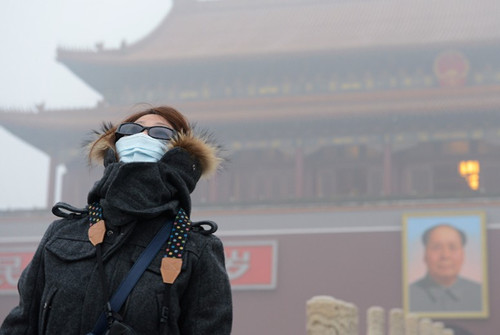China sets up clean-air fund
 0 Comment(s)
0 Comment(s) Print
Print E-mail China Daily, February 13, 2014
E-mail China Daily, February 13, 2014
China will accelerate changes to its energy structure and place tougher controls on exhaust emissions and dust in its fight against air pollution.
 |
|
A woman wearing a mask stands in front of the Tian'anmen Tower in Beijing on Jan. 29, 2013. [File photo] |
The central government has laid out a number of detailed measures that identify large cities and regions with the most frequent smog and haze as key areas in the battle against air pollution, according to a statement released after the State Council's executive meeting presided over by Premier Li Keqiang on Wednesday.
A special fund of 10 billion yuan ($1.65 billion) will be set up this year by the central government. The money will be used to reward efforts to curb air pollution in the key areas.
Other measures include promoting cleaner coal with low sulfur content and curbing coal consumption. Projects will be launched to transmit electricity across regions, which will speed up the adjustment of the energy structure, the statement said.
The State Council also pledged nationwide implementation of Phase 4 of the diesel fuel standard -- which stipulates that fuel must contain less than 50 micrograms of sulfur per gram -- by the end of this year.
Environmental experts said the policies will help carry out the Airborne Pollution Prevention and Control Action Plan, a tough move taken by the central government five months ago to improve poor air quality.
Optimizing energy structure is one of the major issues and requires specific steps, said Wang Jian, deputy director of the Pollution Prevention and Control Department at the Ministry of Environmental Protection.
"For example, the action plan calls on Beijing, Tianjin, and Hebei province to reduce regional coal consumption by 2017, which is simply a goal," Wang said. "To reach the goal, detailed measures need to be launched, including receiving power from outside the three areas, such as from the Inner Mongolia autonomous region and Shanxi province."
He said a central heating system metered by household, which was mentioned at the meeting, is becoming a trend and will develop quickly.
"By metering the heat by household, people can determine the room temperature by themselves rather than having to open windows if it gets too hot inside," Wang said.





